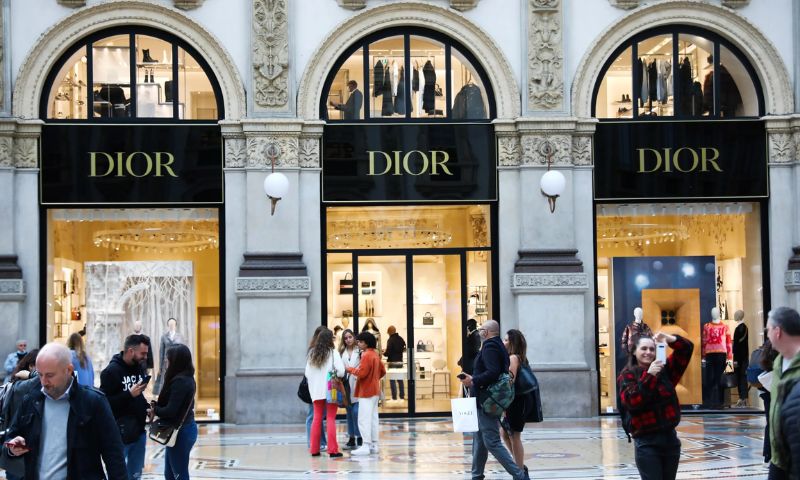Key points
- LVMH and Kering report falling revenues and profits
- Shoppers, especially in China, are spending less on luxury
- US tariffs and economic uncertainty hurt the sector
- Brands must adapt to younger, wealthier buyers
ISLAMABAD: When athletes started to return their 2024 Paris Olympic medals after they began to corrode, it was an omen of things to come.
The medals were designed by French jeweller Chaumet, which LVMH, a luxury goods giant, owns.
Though the French mint produced the medals, LVMH suffered bad publicity after it made a spectacle of its corporate sponsorship of the games, according to a report published by DW.
Paris-based LVMH is not corroding, but it is not doing great either.
In late 2022, the company’s market value soared high enough to make Bernard Arnault, its founder and chairman, who controls about half of the company’s shares, the wealthiest man in the world. Since then, its stock price has seen a notable drop.
The conglomerate, which owns 75 brands like Louis Vuitton, Dior and jewellers Bulgari and Tiffany & Co, is suffering from slowing sales after a post-Covid boom.
Half-year results released on July 24 show revenue down 4 per cent compared with the same six-month period in 2024. Profits from recurring operations were down 15 per cent and came to €9 billion ($10.5 billion).
Sectors like wine, spirits, fashion and leather goods saw revenue and operating profits decline in the first half of the year. While its watches, jewellery, perfumes and cosmetics businesses remained stable.
“A death spiral”
LVMH said the company “showed good resilience and maintained its powerful innovative momentum despite a disrupted geopolitical and economic environment.” Demand in Europe was “solid” and “remained stable” in the US.
LVMH is not the only one suffering. Kering, which is also based in Paris and owns Gucci, Bottega Veneta and Yves Saint Laurent, reported a significant decline in sales in the first half of the year.
“Luxury is in a death spiral,” predicted Katharine K Zarrella in a December 2024 guest essay in the New York Times. “After a decade of nearly unfettered growth, the sector is bombing across the globe. Analysts point to less-affluent buyers reining in their spending and slowing demand in China.”
Tariffs from the US
Uncertainty over tariffs is another headache for the industry. Currently, the Trump administration has put a 15 per cent tariff on European Union goods and a 39 per cent tariff on Swiss goods.
This could have real consequences for the important US market. Many luxury goods are made in France or Italy, and many watches come from Switzerland.
Generally, people spend more freely on personal luxury goods when they are optimistic about the future. But these tariffs could go up, go down or disappear.
No one knows how trade talks will proceed, and many are likely to just wait and see.
Chinese shoppers careful
While some brands are doing fine in China, others are way down, says Imke Wouters, a partner at consultancy Oliver Wyman and a retail expert with 15 years of experience in China.
Looking ahead, Wouters thinks the industry will see more moderate growth than in the recent past. “It’s not like the high days when all luxury brands were doing well,” she said. There will be winners and losers.
US tariffs on European luxury goods won’t impact Chinese buyers, but geopolitical uncertainty is keeping them closer to home. In the past, the Chinese bought around 40 per cent of their luxury goods at home. As they rediscover mainland China, Wouters thinks around 75 per cent is bought within the country.
Big spenders on the way
With many buyers holding back, the luxury goods industry could be facing its most significant setback since the 2008-2009 financial crisis, not counting the COVID shock, according to a new report by consultancy Bain & Company.
Last year, luxury sales were down 1 per cent globally, and this year, they have declined further. Bain analysts foresee a moderate decline of 2-5 per cent for the industry by year’s end, but they believe its prospects will be brighter in the future.
“Rising global incomes, generational wealth transfers, and a projected 20 per cent increase in the number of high-net-worth individuals will further expand the pool of potential luxury buyers,” Claudia D’Arpizio and Federica Levato wrote in a press statement, according to the DW report.
But a bigger pool of shoppers is not enough, warned the pair. “Brands will need to rethink how they engage younger consumers, avoid over-reliance on top spenders, and build emotional connections that go beyond transactional loyalty.”




























